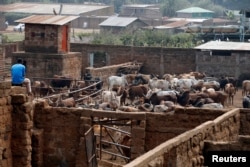An abattoir located among herding communities in Ethiopia's eastern Somali region, known more for droughts and famine than business opportunities, is an unusual stop for a U.S. aid administrator.
But USAID chief Mark Green stopped at the Jijiga Export Slaughter House (JESH) during a visit to the town of Jijiga on Wednesday to see the effects of a crippling drought that has pushed some areas to the south to the brink of famine.
The abattoir buys goats, sheep, cows and camels for slaughter from herders for export to the Middle East, giving families cash to buy food during the drought.
A $1.5-million loan from Feed the Future, a $1 billion-a-year agricultural program launched during U.S. President Barack Obama's presidency in 2010, helped purchase refrigerators and trucks for the facility, which employs 100 people from local villages.
To Green, the slaughterhouse represents what USAID can do to help attract private-sector money into investments that boost the productivity of small farmers in developing countries.
While at the abattoir, Green announced 12 countries that will benefit from Feed The Future investments in 2017, signaling that the program will survive proposed deep cuts to USAID's budget this year.
The 12 countries are Bangladesh, Ethiopia, Ghana, Guatemala, Honduras, Kenya, Mali, Nepal, Niger, Nigeria, Senegal and Uganda.
Green said investments like the Jijinga slaughterhouse not only created markets for American businesses but helped communities out of poverty. Herders can earn as much as $80 per goat when they sell to the slaughterhouse.
“I’m under no illusions; the development journey in many places in the world is a long one, but I want us to always be thinking what we can do that nudges something towards a day when people get to take care of themselves,” he said.
“This is a place where we see some of the benefits and the potential for Feed the Future,” Green added.
JESH Chief Executive Faisal Guhad said the abattoir had been open for a year but was forced to close for three months last year because of the drought.
The facility currently processes about 10,000 animals a month. Guhad said he hoped to quadruple that in the second year of operation.
Demand for Ethiopian goat meat was currently high because of the annual haj pilgrimage to the holy city of Mecca, said Guhad.
“We opened at the wrong time. El Nino happened to us and we started again after it rained,” said Guhad. “We're now in the second month of starting again.”
The facility employs about 108 people from the community and plans to increase hiring to 200, said Guhad.
In the Jijinga area, planting for the March to May rains, known as the belg, is already delayed, and aid workers say they have seen a growing number of women and children at food distribution centers. The hunger crisis is predicted to worsen until the harvest begins in September.
Many parts of the Ethiopian highlands are still recovering from the 2016 drought, which was attributed to the El Niño weather phenomenon in the Pacific Ocean.







